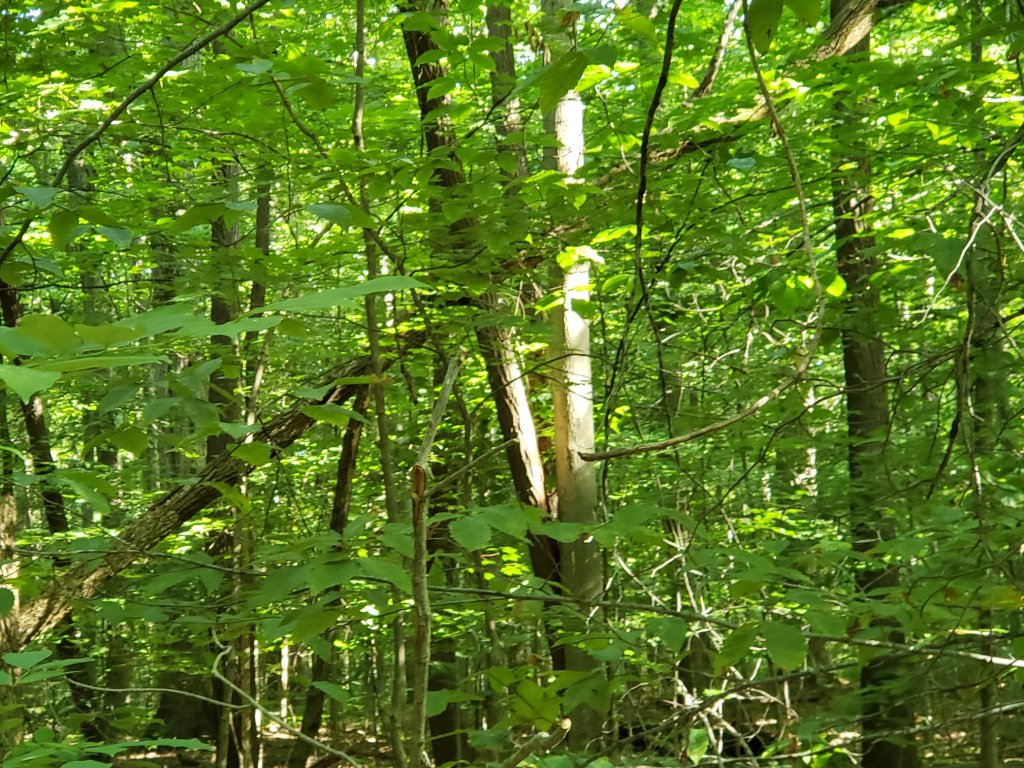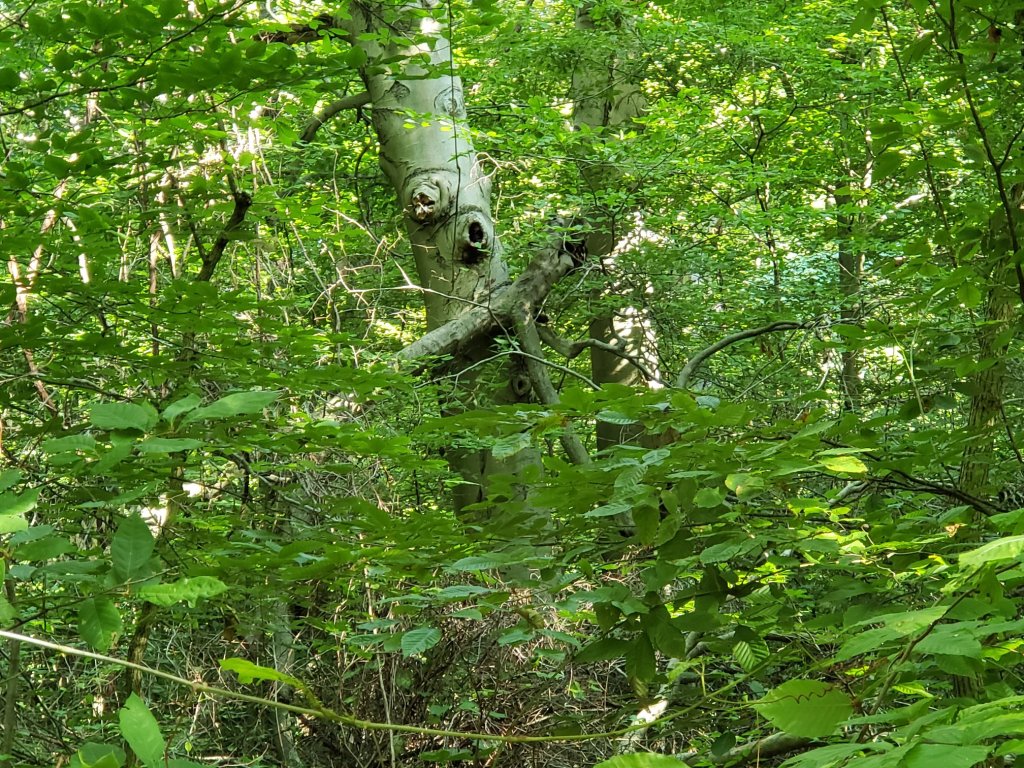“One thing I’ve learned in the woods is that there is no such thing as random. Everything is steeped in meaning, colored by relationships, one thing with another.” ~Robin Wall Kimmerer
I have a thing for dead trees resting in the branches of living trees. I’m sure forestry management types consider this a potentially dangerous situation, but I find them beautiful. I cherish the music these tree partners make in the wind, almost like whale songs rising from the woods.
When I shared some pictures on social media, poet friend RC Wilson responded, ”Mark Twain indicated that a tree limb in the river that oscillated up and down in the current, like the arm of a man sawing wood, was called a sawyer. Seems like some of the music you describe is a rubbing sound caused by the wind moving the living tree so that the dead tree rubs against it like the bow of fiddle. So how about fiddlers? Yeah, ‘widow maker’ acknowledges the deadliness of that arrested potential energy, so watch out for widow makers when you set up your tent, but also listen for song of the fiddlers that trees have sung forever.”

Friend and former colleague Shay Seaborne wrote that she sees the living tree as a “tree death midwife.” I think she’s got something with that midwife observation. As Suzanne Simard, author of Finding the Mother Tree: Discovering the Wisdom of the Forest, said in a recent NPR interview,
Dying is a process, and it takes a long, long time. It can take decades for a tree to die. In the process of dying, there’s a lot of things that go on. And one of the things I studied was where does their energy — where does the carbon that is stored in their tissues — where does it go? … About 40% of the carbon was transmitted through networks into their neighboring trees. The rest of the carbon would have just dispersed through natural decomposition processes … but some of it is directed right into the neighbors. And in this way, these old trees are actually having a very direct effect on the regenerative capacity of the new forest going forward.
This is a completely different way of understanding how old trees contribute to the next generations — that they have agency in the next generations.

One of my favorite current jobs is serving as editor of a publication called Braided Way: Faces & Voices of Spiritual Practice. A few years ago we published an unforgettable essay titled “Old Mother Tree” by Suprabha Seshan, who lives and works at the Gurukula Botanical Sanctuary in Kerala, India. She wrote,
There are as many stories as there are beings in this forest. Worms, ants, spiders, trees, epiphyllous liverworts, laterite nodules interpenetrated with alga, maggots, eggs, seeds, filaments of fungi; waters bearing beings, beings bearing water; lung cells, and skin cells talking to the air, and air talking to the leaves; multiplicitous symbionts forming composite entities, the whole forest is alive. There is nothing that is not part of life, where do the elements end and organisms begin?
…Around me are crowds of beings but there is no waste. Everybody is food for somebody else. The innumerable myriad beings transform their world, the forest. They create it and eat it, make love in it and die in it. Their bodies are worlds for other beings. Individual presences are palpable, even though there are so many. They are all apparently independent, and carrying on with their individual lives. They are also interdependent. This creates a whole. And a constancy.

I see these gentle partner trees from the highway, on hikes, and in the quiet backlots of what our species calls “undeveloped” lots. They fill me with a quiet peace each time.
“Even a wounded world is feeding us. Even a wounded world holds us, giving us moments of wonder and joy. I choose joy over despair. Not because I have my head in the sand, but because joy is what the earth gives me daily and I must return the gift.” ~ Robin Wall Kimmerer
I was just talking to my nephew about Braiding Sweetgrass, here the author pops up again unbidden but welcome. Let us be sister trees together.
LikeLiked by 1 person
We already are, my friend.
LikeLike
They are called Nurse Logs, because they provide nutrition, nurture and a safe haven for the great and small ecologies of the forest. (https://www.americanforests.org/blog/nurse-logs-healers-forest/). I love the idea of the slow, soft decay of the tree giving sustenance to all around it.
LikeLiked by 1 person
Living scripture, right there.
LikeLiked by 1 person
The duality of Nature can be cruel with the charm of the ecology, however: the “widow maker,” joins the cute predators who prey but don’t pray.
The charm of a home requires neatness they say, but there is a sadness when people rake leaves under a tree and throw them away. The tree deliberately kills the leaves before winter by sucking out as much of the leaves’ nutrients as it can to save for the winter, but it can’t save the shell. The remainder is supposed to fall near the tree, decay, and be reabsorbed from the soil by the roots.
There is an odd glorification of ‘Mistletoe’, however: it’s not really romantic because it’s a parasite that sucks nutrients out of a tree that’s trying to rest for the winter. I wonder how many rakers like mistletoe. Yeah, I knew a girl who kissed under the mistletoe, climbed trees, and I thought:
Yes, trees can branch
that’s their slow motion adventure
when they must wait for seed carriers
that bear their fruit
Maybe she’ll come down
for our favorite wine
and a dithyramb
about ecstasy
and leafy love
I have seen her dither,
climb a tree in bloom
speak with flirty birds
and have a word with me
that is a subtle twitter bark
surrounding like a hug wood
a play with banter-word chirps
But wilder is better because
even in flighty tedium whims
she knows the prolix eagles
who extend their wings
and cry for hours when
she speaks their language
With a waiting twiddle I wanted much
to touch her since then, and
there is a flourish in melody
that accompanies the twaddle
of the giddy blooming of me
I hear when I think
of her as branching music
reaching for the sky
I know she’s reading
between tweets
sneaking a look at
longer things like me
world famous innuendo…
LikeLike
Innuendo in a tree post comment indeed.
LikeLiked by 1 person